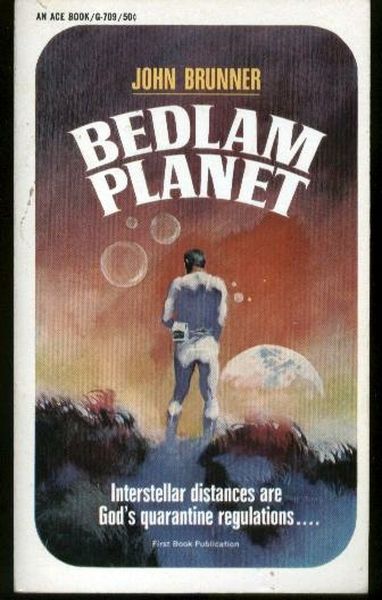Our Separate Ways
Bedlam Planet
By John Brunner

26 Sep, 2023
John Brunner’s 1968 Bedlam Planet is a stand-alone science fiction novel.
Most of the nearby solar systems visited by humanity’s first faster-than-light probes contained only dead worlds. Sigma Draconis was the notable exception. Asgard is in many ways Earth’s twin, a world on which humans can survive unprotected. Or so the initial scouting mission suggested. The colonists planned to test Asgard’s habitability for themselves, assisted by two of the original scouts, Pyotr Tang-Lin and Dennis Malone. Starflight being fearfully expensive, the settlers will be left to succeed or fail without help from Earth1.
The settlement begins badly, with a tragic mishap.
Emerging from qua-space, the colony ship Pinta collides with Asgard’s moon. Everyone is (of course) killed and the starship reduced to fragments. The settlement will have to get along without a third of its planned population and only two thirds of its supplies. Among the dead: pilot Pyotr.
The original plan was for one of the three starships to be cannibalized for parts, one to return to Earth after a year conveying the two scouts and any dissatisfied colonists, and the third to serve as an emergency evacuation vehicle if colonization should fail. With one ship lost along with its pilot, that plan must be discarded. One ship is cannibalized and the other remains on Asgard.
Dennis never intended to be a colonist, only an advisor. Marooned on Asgard, he struggles to come to terms with his situation and to find a useful niche in the colony. He is painfully aware that his previous sojourn on the planet featured a bout of mania. While the mental health experts cleared him for the return trip2, that was for a one-year stay, not life.
Personal issues are eclipsed by a general concern. The initial scouting mission found no infectious diseases. The colonists discover that in fact at least one of the local microorganisms can live in humans. While it does not have directly deleterious effects, there is a secondary consequence of tremendous importance. Lacking a particular nutrient on which it depends, the microorganism makes do with Vitamin C. Consequently, a wave of scurvy sweeps the colony.
It is possible that by eating local plants, they could provide the microorganism with its missing nutrient. However, a new complication arises. To eat the plant life is to go mad. In short order, the colony’s meager supplies are reduced further as advanced technology proves all too vulnerable to sabotage.
Madness or scurvy? The choices both seem fatal … if one has the wrong perspective.
~oOo~
This week in my on-going series, James Connects Two Books That Are Probably Unrelated: having reread Bedlam Planet, I am reminded of C. J. Cherryh’s 1983 Forty Thousand in Gehenna, in which adaptation to an alien planet also imposes some interesting cognitive transformations.
Another comparison that comes to mind is Brian Stableford’s Daedalus Mission series, which ran from 1976 to 1979. Like the Daedalus Mission books, the evidence strongly suggests that this was a premature colonization effort. Economic and scientific factors mean the margin for survival is slender. Unanticipated setbacks can easily snowball and doom the settlement.
One might expect from the fact the settlers’ starships are called the Pinta, the Nina, and the Santa Maria3 that the colonists would bring with them the ethic that native life is to be swept aside to make room for Terran life. In fact, the colonists are quite aware that upending the local biosphere could have lethal consequences. Alterations are limited to islands. The world-ocean is sacrosanct.
While the problem facing the colonists is at its heart a technical one — how do they survive on Asgard with the resources at hand? — the novel’s focus is on psychological factors. Large swaths of the narrative are devoted to various characters’ hallucinations, as they try to adapt their cognitive processes to their new environment. This concern with inner worlds and the trippy surrealist passages may have seemed to some readers suspiciously reminiscent of the New Wave4.
Viewed more than half a century later5, Brunner’s novel stands up well. While it is much shorter than its modern equivalents would be, Brunner uses his limited space efficiently and to great effect. I almost wish this was a weekly project and not monthly.
Bedlam Planet is available here (Amazon US), here (Amazon Canada), here (Amazon UK), and here (Barnes & Noble). It is available here (Kobo). I did not find it at either Apple Books or Chapters-Indigo.
1: It’s a plot point that hundreds of robot probes were built and also a plot point that they can be reused. It’s not at all clear why one wasn’t commandeered to run messages between Asgard and Earth.
2: The two women from the first mission refused to return at all. Dennis credits this to the women having their pick of men on Earth, but I think the real reason might be because Dennis tried to rape one of them.
3: One might also expect from those names an extremely European assortment of settlers. Not so! The settlers are a surprisingly (for the 1960s) diverse lot, something the narrative is at pains to point out.
4: Curiously, the novel appears to have been overlooked by reviewers when it first appeared; the two reviews I see on ISFDB are from the mid-1970s.
5: Existential screaming.
